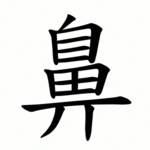Radical 209
Appearance
| 鼻 | ||
|---|---|---|
| ||
| 鼻 (U+9F3B) "nose" | ||
| Pronunciations | ||
| Pinyin: | bí | |
| Bopomofo: | ㄅㄧˊ | |
| Wade–Giles: | pi2 | |
| Cantonese Yale: | bei6 | |
| Jyutping: | bei6 | |
| Japanese Kana: | ヒ, ビ hi, bi hana はな | |
| Sino-Korean: | 비 bi | |
| Hán-Việt: | tị | |
| Names | ||
| Japanese name(s): | 鼻偏 hanaben | |
| Hangul: | 코 ko | |
| Stroke order animation | ||
 | ||
Radical 209 meaning "nose" is 1 of 2 Kangxi radicals (214 radicals total) composed of 14 strokes.
In the Kangxi Dictionary there are 49 characters (out of 49,030) to be found under this radical.
Characters with Radical 209
[edit]| strokes | character |
|---|---|
| +0 | 鼻 |
| +2 | 鼼 鼽 |
| +3 | 鼾 鼿 |
| +5 | 齀 齁 |
| +8 | 齂 |
| +9 | 齃 齄 |
| +10 | 齅 齆 |
| +11 | 齇 |
| +13 | 齈 |
| +22 | 齉 |
Sinogram
[edit]As an independent sinogram 鼻 is a Chinese character. It is one of the Kyōiku kanji or Kanji taught in elementary school in Japan.[1] Specifically it is a third grade kanji.[1]
References
[edit]- ^ a b "The Kyoiku Kanji (教育漢字) - Kanshudo". www.kanshudo.com. Archived from the original on March 24, 2022. Retrieved 2023-05-06.
Further reading
[edit]- Fazzioli, Edoardo (1987). Chinese calligraphy : from pictograph to ideogram : the history of 214 essential Chinese/Japanese characters. calligraphy by Rebecca Hon Ko. New York: Abbeville Press. ISBN 0-89659-774-1.
External links
[edit]Wikimedia Commons has media related to Radical 209.
